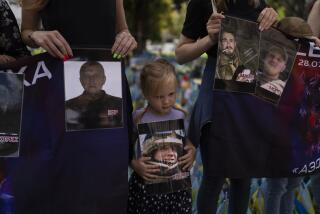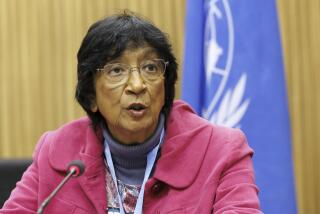U.N. report cites ‘clear’ use of chemical weapons in Syria
- Share via
WASHINGTON — A United Nations report finding “clear and convincing evidence” of a deadly chemical attack built new momentum Monday for demands by the United States and allies to impose tough penalties on Syria if it fails to honor promises to surrender its arsenal.
Although the 38-page report from a U.N. scientific team does not assign blame, Western diplomats and independent experts said it offers undeniable evidence that Syrian President Bashar Assad’s forces fired sarin-filled rockets with Russian markings into Damascus suburbs on Aug. 21. The United States says more than 1,400 people were killed.
Western diplomats said the weapons and sarin described by U.N. experts displayed sophisticated manufacturing techniques beyond the capabilities of rebel forces, and that U.N. data about the trajectory of the rockets indicated that they were fired from government-held territory.
“The technical details of the U.N. report make clear that only the regime could have carried out this large-scale chemical weapons attack,” said Samantha Power, the U.S. ambassador to the United Nations. “It defies logic to think that the opposition would have infiltrated the regime-controlled area to fire on opposition-controlled areas.”
DOCUMENT: U.N. report on chemical weapons use in Syria
The report, which is the first independent analysis of the attack, carries special weight because it comes just as the U.N. Security Council is debating how to enforce a U.S.-Russian plan under which Assad is to give up all his chemical weapons by the middle of 2014. The United States, France and Britain are pressing the council to adopt an “enforceable and binding resolution” with remedies that could include force. Russia, Syria’s closest ally on the council, has balked at any suggestion of military action.
Many countries, recalling the faulty American intelligence before the 2003 invasion of Iraq, have withheld judgment on the attack pending the report by the U.N. team, headed by Swedish neurobiologist Ake Sellstrom, who is a recognized authority on chemical weapons. The U.N. report is largely consistent with U.S. intelligence on the attack, but the U.S. report goes further in implicating Assad’s forces.
Announcing the joint plan on Saturday, U.S. and Russian officials gave Assad seven days to declare Syria’s entire stockpile of chemical weapons.
The Security Council may take more than a week to agree on a resolution spelling out the rules for Syria’s surrender of its chemical weapons. Many governments, including the United States, are worried that Assad may seek to drag out the process, conceal some of the weapons or obstruct inspectors, as he has done in the past. Assad did not acknowledge that his forces had chemical weapons until after Russia proposed that he turn them over to international authorities.
Though there may be only a small chance of the Security Council authorizing military action, if Syria repeatedly violates its agreement there could be a surge in international support for action by a “coalition of the willing” outside the U.N. auspices, or a U.S. unilateral action.
Ban Ki-moon, the U.N. secretary-general, said the experts’ findings “are beyond doubt and beyond the pale. This is a war crime.”
The U.N. team interviewed dozens of survivors and relief workers, analyzed blood, hair and soil samples, and collected fragments of 140-millimeter surface-to-surface rockets that each carried slightly more than 9 gallons of the nerve agent sarin. The report says that because the human-sized rockets were fired at night, when temperatures were cool, the sarin gas clung to the earth and killed victims who sought shelter underground.
The report says the team found consistent symptoms, including “shortness of breath, eye irritation, excessive salivation, convulsions, confusion/disorientation and miosis,” or constriction of the pupils. First responders told the investigators that they suffered “blurred vision, generalized weakness, shaking, a sensation of impending doom, followed by fainting.”
“There is no doubt that the attack was perpetrated by the Damascus regime,” said Alexis Lamek, the deputy French ambassador to the United Nations.
Germany had resisted U.S. efforts to build support for strikes on Syria, but the Foreign Ministry said Monday that the report showed the attack was a “crime against civilization and requires a determined U.N. Security Council resolution.”
Vitaly Churkin, Russia’s ambassador to the United Nations, pushed back against the Western arguments, saying that experts first needed to “absorb the entire volume of information contained in the report.”
“We need not jump to any conclusions,” said Churkin, whose country has sided with Syria in arguing that the rebels were responsible.
Moscow may be embarrassed that the rockets cited by the report bore Russian markings, although the finding could have little significance. Russian arms are found throughout the region, and a Human Rights Watch report says those used in the attack dated from the Soviet era. It was unclear whether the rockets were for use specifically with chemical weapons or could be used to deliver conventional weapons as well.
Mark Fitzpatrick, a former State Department official at the International Institute for Strategic Studies in London, predicted that the report would strengthen the prospects for a U.N. resolution authorizing use of force if Assad fails to meet the deadline he is facing for declaring his stockpiles.
Though many European countries have been hesitant to support action against Assad, Fitzpatrick predicted that the level of outrage among many of those countries “will be very high.”
Faiza Patel, a former senior policy officer at the Organization for the Prohibition of Chemical Weapons, which oversees the principal treaty banning the weapons, said the report’s conclusions could create more pressure for a swift international response.
“I don’t think anyone has seriously been denying chemical weapons had been used Aug. 21. This kind of gives that conclusion a U.N. seal,” Patel said. “When you put the report together with other information it strongly suggests that the regime is responsible.”
The next step in the process will come when the organization issues a decision on the U.S.-Russian request for an accelerated timeline to impound or destroy the weapons. A spokesman in The Hague for the organization said it would issue a decision by Friday.
The OPCW’s director general, Ahmet Uzumcu, said in a statement that the U.N. report confirming use of chemical weapons in Syria “is a tragic development that I condemn strongly. This clearly makes it all the more important to ensure that the program for chemical demilitarization in Syria succeeds.”
Separately, President Obama on Monday waived rules that restrict export of some chemical weapons-related protection equipment so that the gear may be available to the OPCW during inspections in Syria. The waiver will also make equipment available to healthcare providers in Syria and U.S.-backed opposition forces.
The Human Rights Watch report issued last week, based on analysis of videos and witness accounts of the attack, concludes that 140-millimeter and 330-millimeter artillery rockets were used to deliver the poison gas. The advocacy group said its experts and independent analysts had never seen Syrian rebel forces possessing or using such rockets, leading it to conclude that Assad’s forces had launched the attack.
On Monday, Peter Bouckaert, Human Rights Watch’s emergencies director, said the U.N. report confirmed the organization’s conclusions.
paul.richter@latimes
More to Read
Sign up for Essential California
The most important California stories and recommendations in your inbox every morning.
You may occasionally receive promotional content from the Los Angeles Times.












